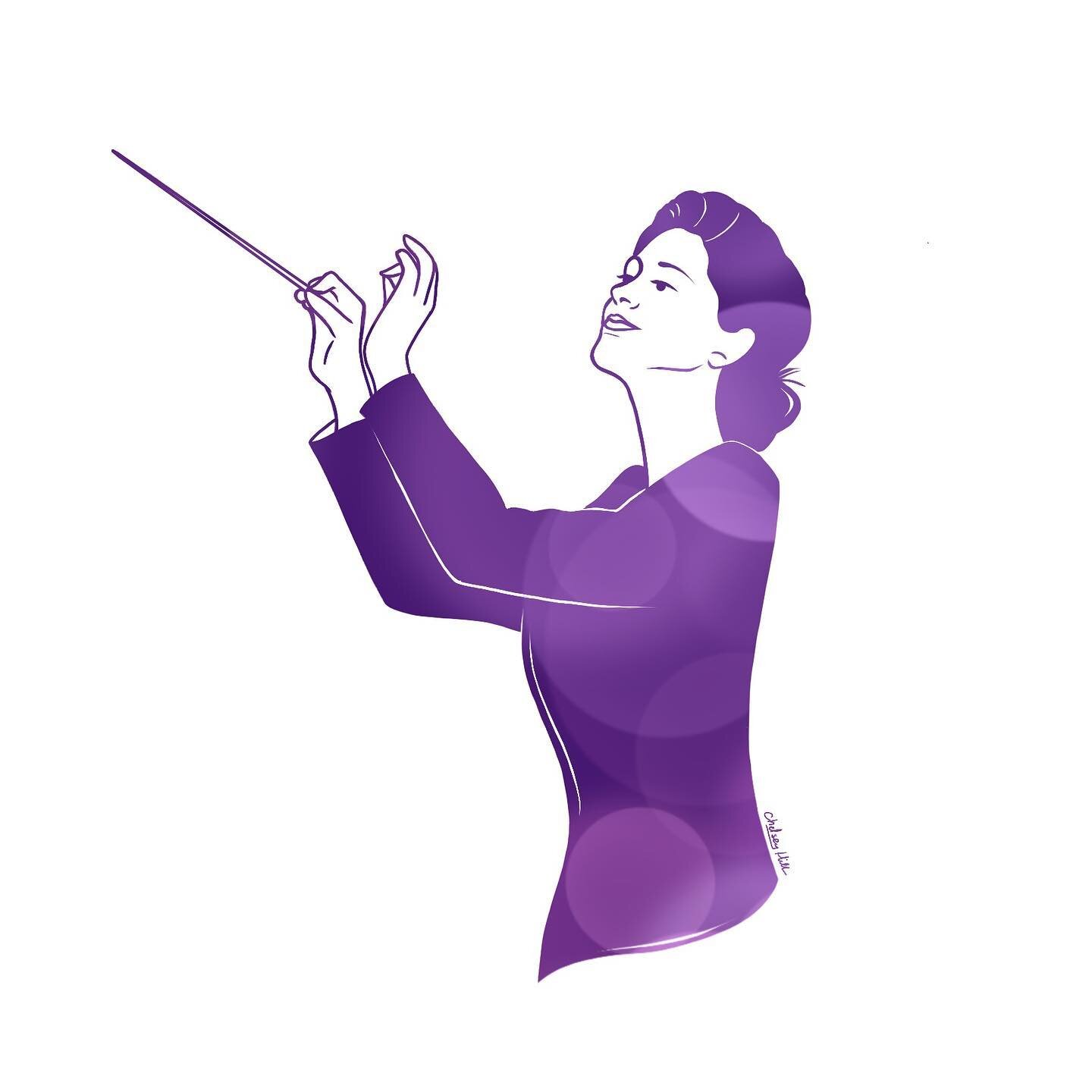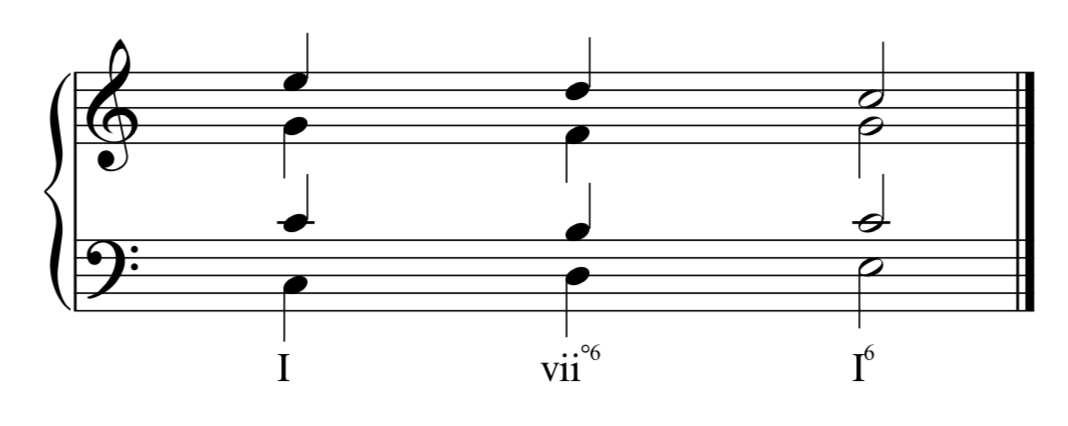TRIADS IN FIRST INVERSION
A chord (triad, seventh chord, or any other chord) with the 3rd scale degree in the bass and the root somewhere above is said to be in FIRST INVERSION. For a triad, this would mean the chord is spelled (from bottom to top) either 3 - 5 - 1 or 3 - 1 - 5. The order of the chord tones above the bass is not important - what is important (and what makes it in first inversion) is that the 3rd scale degree is in the bass. First inversion triads will use the superscript “6” as in I⁶ and first inversion seventh chords will use the superscript “6/5” as in I⁶⁵.
WHY USE FIRST INVERSION CHORDS?
There are two main reasons to use first inversion chords:
Using any chord inversion in addition to root position gives more variety to a piece of music
Using any chord inversion allows for a more melodic bassline
In the two examples above, the version with the addition of a first inversion chord (resulting in the movement of 1 - 3 - 5 - 1 in the bass) is a richer and more interesting excerpt of music. Notice that the I⁶ chord replaced a beat of the root position I chord. First inversion chords serve as good harmonic replacements for root position chords. As we will learn next week, second inversion chords do not because they are too harmonically unstable.
VOICE EXCHANGE
Another element to notice in the example above is called VOICE EXCHANGE. This is when the same Roman Numeral chord is repeated twice in a row but instead of playing the chord with the same exact voicing, notes are exchanged between the different voices. This will result in either an inversion change (such as root position to first inversion) or the bass might stay the same in both chords and upper voices will exchange the chord tones.
Voice exchange is another way to make music more interesting - instead of holding a single voicing for a longer duration, voice exchange energizes the piece with movement.
Now let’s see how first inversion chords are used in context …
TYPES OF FIRST INVERSION TRIADS
NEIGHBOR CHORD
This is a type of EMBELLISHMENT CHORD (meaning you could remove it from the harmonic progression and it wouldn’t really matter). It is used to do something interesting if you need to hold out another chord for a long time but that feels too boring.
It is called a NEIGHBOR chord because the bass moves from the root of one chord to the third of another chord and back - but these notes are one step away from each other in the scale (so they are neighbors). It’s like the bass is at home, visits its next-door neighbor, and goes home again.
In major, you will see Neighbor First Inversion Triads often as: I - V⁶ - I. The bass movement in this progression is 1 - 7 - 1. This isn’t the only instance one would use a Neighbor Chord.
INCOMPLETE NEIGHBOR CHORD
This chord is similar to above but the movement is slightly disrupted. In the analogy of visiting one’s neighbor, an INCOMPLETE NEIGHBOR chord happens when the bass starts at home, visits its next-door neighbor and then jumps to an inversion instead of returning home. It also works in reverse - the bass note starts in inversion (away from home), and stops to visit its next-door neighbor on the way home.
Two examples of this first inversion triad type are: I - V⁶ - I⁶ which has the bassline of 1 - 7 - 3 or I⁶ - V⁶ - I which has the bassline of 3 - 7 - 1. These aren’t the only instances one would use an Incomplete Neighbor Chord.
PASSING CHORD
The PASSING CHORD is named for the movement of the bass passing from a root position triad to the first inversion of the same triad while passing through a first inversion triad on the way. In the example, we see: I - viiᵒ⁶ - I⁶ that has the bass movement of 1 - 2 - 3. You may ask, why can’t we just use a ii chord for the 2 in the bass? Well, this would create several problems:
First, moving from I - ii would risk parallel octave and parallel fifth motion.
Second, the root position from I - ii strengthens the position of the ii more than necessary.
Thirdly, including a root position ii chord before moving back to a I⁶ essentially creates a very fast TONIC - PREDOMINANT - (weak) TONIC motion that makes little sense harmonically.
By incorporating the viiᵒ⁶, the harmonic movement becomes TONIC - (weak) DOMINANT - (weak) TONIC which is much more logical.
*When using any kind of viiᵒ chord, be sure to not double the root (scale degree 7) as the tendency of the leading tone of the scale to resolve to scale degree 1 will result in parallel octaves. In this example, we see that scale degree 2 (the 3rd of the chord) is doubled.
*You may have noticed that the Alto and Tenor voices appear to be moving in parallel 5ths (C/G - B/F - C/G). While this visually appears to be parallel 5ths, it is not because the interval of B-F is a tritone. So the movement here is P5 - d5 - P5 which is totally acceptable.
Another common use of the passing first inversion triad is V - IV⁶ - V⁶ which creates a bassline of 5 - 6 - 7. Note that both of these examples could also be performed in reverse and the first inversion triad would still be a (descending) passing chord.
ARPEGGIATION CHORD
In this setting of a first inversion chord, it will be used to complete an arpeggiation sequence in the bass. Returning to the example at the very top of this page, the movement of I - I⁶ - V creates a bassline of 1 - 3 - 5 which - when devoid of vertical harmony itself - is the arpeggiated outline of a I triad (1 - 3 - 5). This is very similar to a passing chord in its movement but while a passing first inversion triad would result in stepwise bass motion, the arpeggiating first inversion triad results in triadic (third) bass motion.
HOW FIRST INVERSION CHORDS EXPAND THE TONIC
While V - I is the shortest possible complete harmonic sequence in music (just two chords), most phrases of Western Classical music follow the journey of TONIC - PREDOMINANT - DOMINANT - TONIC. This movement can be accomplished in as little as four chords but there are many combinations of chords as well as time spent in each area in order to develop a unique and customized “journey.” EXPANSION of tonal areas takes place when additional chords are added to a tonal area (T, PD, or D) and this expansion is a way to lengthen the duration of that area before moving on to the next area. All of the above applications of first inversion triads are ways of expanding the TONIC as outlined in the following diagram.
HOW FIRST INVERSION CHORDS EXPAND THE DOMINANT
Just as first inversion triads can expand the Tonic, some can also expand the DOMINANT. In the diagram below, we see that the best way to use a first inversion triad to expand the Dominant is by starting on a V or V⁶ and passing through a IV⁶ to add length to the Dominant area of a phrase.








